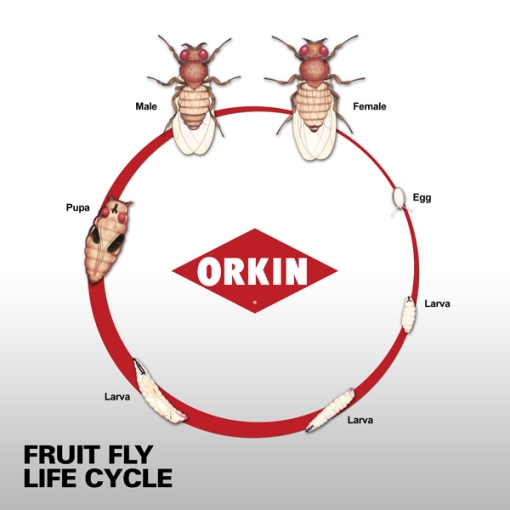
Fruit flies getting it on. Taken from http://www.nature.com/nature/journal/v489/n7414/images/489038a-f1.2.jpg
You’re a third year biology student confused about what on earth you’re going to do once the diploma is in hand. Where will you work? What will you specialize in? Do you have what it takes to do a masters, as your chances of getting work with just a bachelors degree is slim to none?
Your solution? Do an 8 month honours project.
If you’re particularly gung-ho, do two at the same time. (Actually, don’t. It wasn’t one of my better life choices. More on this later).
Once you’ve decided that you’re going to dedicate 8 months of your life to a certain topic, you have to decide what that topic is going to be. For me, this was relatively easy. I liked insects. I liked evolution. So I signed up with a professor who did too. He used fruit flies to study various evolutionary theories. Piece of cake!
After reading many journal articles to make sure our brilliant study had not already been done by someone else (this is an occupational hazard in research), we decided on an experiment.
I would find out what female fruit flies found sexy about the males.

A male Drosophila psuedoobscura flaunting a transparent abdomen complete with orange testes. Photo credit Alex Wild. http://blogs.scientificamerican.com/compound-eye/2013/07/03/drosophila-pseudoobscura-a-model-fruit-fly-for-the-real-world/
We suspected it had something to do with the male’s orange testicles. Because, seriously, why else would you have a transparent abdomen and bright orange testes if not to impress the ladies?
As you can imagine, fly sex is a great topic at dinner parties. I am usually asked the following questions:
Q: There are fruit flies everywhere in my kitchen! Can I donate them to you?
A: I understand your pain, but my lab does not take fly donations. I was looking at a very specific species, Drosophila pseudoobscura, which lives in western North America. The flies I worked with originally came from Arizona, but had been bred in labs for many generations to get as uniform a population as possible.
Q: Do all flies have orange testicles?
A: No. I haven’t studied the behinds of other flies, so I can’t say for sure if there are other species out there with florescent testes. There may be, who knows?
Q: Can you see fly testes?
A: Well, the flies are tiny (5mm), so their testes are miniscule. You can see them with the naked eye, but to study them I took pictures using a dissecting microscope.
Q: How to you make flies stand still for pictures?
A: I asked them nicely. Just kidding. I gassed them with carbon dioxide, which knocks them out for a few minutes.
Q: Did you watch fruit flies having sex?
A: (Sigh). Of course I did. To find out which males the females found most attractive, we put two virgin males in an arena with a virgin female. The male she chose to have sex with was the one she liked best. Believe me, the novelty of watching fly sex wears off after the 10th coupling.
Q: Wait a minute, why did you use virgin flies?
A: We had to make sure all our flies had the same level of sexual experience. Like humans, flies can learn from past experiences, which subsequently affect they find attractive in a mate. We wanted our females to have a clean slate.

Here is a lovely life cycle from a pest control company. I guess that it’s important in their line of work! http://www.orkin.com/flies/fruit-fly/life-span-of-fruit-fly/
Q: How do you know for sure that your flies are virgins?
A: Fruit flies have a lifecycle similar to butterflies. In D. pseudoobscura, the adult flies can’t reproduce until 48 hours after they struggle out of their pupa (Snook & Markow, 2001).When my flies started emerging from their pupae, I segregated them by sex every 24 hours to make sure they couldn’t get up to any funny business. Sorting hundreds of flies is not an exciting way to spend your Saturday, and thankfully I only had a few Saturdays like that.
Q: What did you find out? Do females find orange testes sexy?
A: Unfortunately, they do not. The size and colour of a male’s testes had nothing to do with whether or not a female chose him. We found the females were more interested in the male’s pheromones, and were selecting mates based on that.
Q: Then why do the males have orange testes?
A: I have no clue. But it’s not related to sex. If you find out, let me know.
Q: Is your research applicable to humans?
A: Not in the slightest! It’s true that flies and humans share many genes, and flies are used as model organisms in studies that can apply to humans. However, human courtship and fly courtship are worlds apart. In fact, different fly species have different kinds of courtship. Therefore, my research can only be applied to this species of fly. Unless, of course, you know any humans with orange testes…
Note: Alex Wild has some more beautiful pictures of some pseudos on the Scientific American blog. Apparently they are an under-photographed species. Go check them out, and remember to look for the orange!
Snook, R. R., & Markow, T. A. (2001). Mating system evolution in sperm-heteromorphic Drosophila. Journal of Insect Physiology, 47(9), 957-964.


Pingback: And now for something completely different | lab bench to park bench